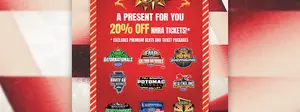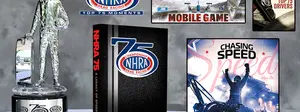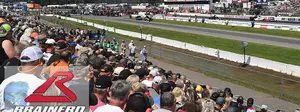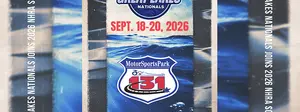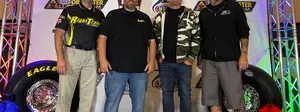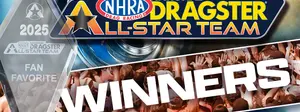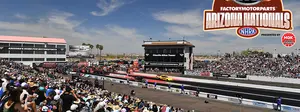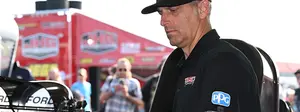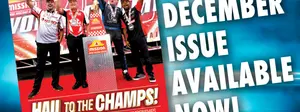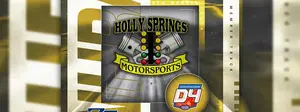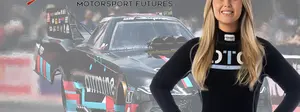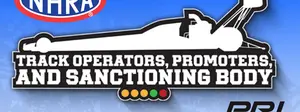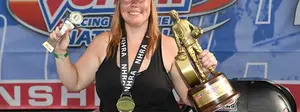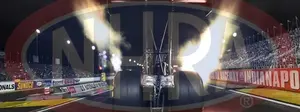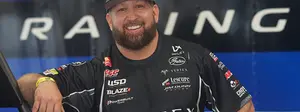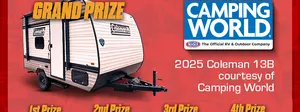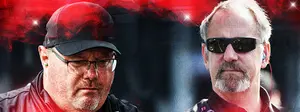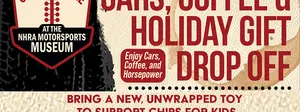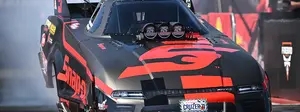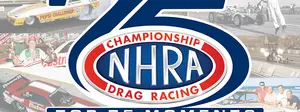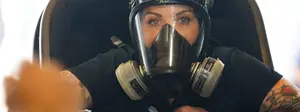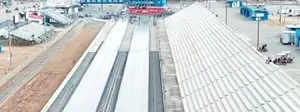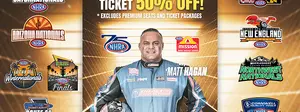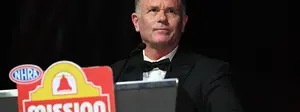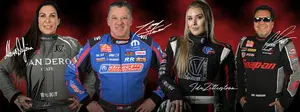

NHRA announces new Factory Experimental racing class for 2022
Ford, Dodge, Chevy, and Toyota factory racing fans, this is the moment you've been waiting for.
Brian Lohnes:
Lonnie is the National Tech director for NHRA, which means he has his hands in a lot of things and works with a lot of folks behind the scenes to not only manage rules packages for our racing classes that exist today, but also creating new racing categories. And he has got a big announcement. We are here today to announce a new category, a new class of NHRA drag racing, and Lonnie I'll let you take it away.
Lonnie Grim:
So I am so excited here. There is, this has been working progress for almost six months now. I come from places where we can move the marker and move it quick. In the NHRA, we move it cautiously. Over the years there is a great group of people and a great group of supporters behind me, here within NHRA that makes sure that we are doing things the right way headed in the right direction. And so I come on board, we started having talks and throwing ideas around. And one of the things that we are proud to announce today is, for the history buffs within the NHRA, there used to be a class called Factory Experimental. And that was a way that the OEs could build a one-off car, even a team to build a one-up car and show up on the racetrack at any of our events, any of our national events and run it under a category called Factory Experimental. What we've done is we've saved the name, but we brought it to a new modern technology Factory Experiment I'm proud to announce will be 100% back to race on Sunday, sell on Monday. It is a 100% stock dimensional car. It's going to weigh 2,650 pounds. It's going to have a legal Factory Showdown engine in it. Ford, Dodge, and Chevrolet. It'll have a five-speed manual transmission that looked like come out of a Pro Stock car set behind the firewall, and they'll have a driver, they'll have a brake pedal clutch pedal, and a gas pedal.
Brian Lohnes:
It takes things back in so many ways to the kind of brutally simple days of drag racing, but only in the only the overall structure of the car we're talking about here, I mean: , gas pedal, brake pedal clutch pedal, the manual transmission, the technology of course, involved in developing the chassis underneath that modern car, developing the horsepower out of the modern fuel injected supercharge Factory Stock Showdown engine. Why was this class devised? What was the impetus behind it?
Lonnie Grim:
So there is a pretty huge step up right now. If you, if you move from Top Sportsman, your move would be to Pro Stock. There are a few Comp eliminator classes; B altered, A altered, C altered that might move you towards the Pro Stock category, this, this allows not only OEM involvement, this is not only tied to Ford, Chevy and Dodge. There are others that are invited in. Toyota. But this also allows a car that the average fans set in the stands looks at and goes, Hey, I drove one of those to the racetrack today. My Mustang setting in the parking lot was just like that. One of the things that looks very achievable; the other side of it is that we took away a lot of the very high-end expensive technology, especially in the suspension. So this is an affordable shock package and suspension package that is within the rules set by Factory Experimental.
Brian Lohnes:
And not that you didn't understand those, but to clarify a point the car must have a manual transmission. There is no automatic transmission option here. It has to have a stick in it.
Lonnie Grim:
That is right. The other thing that within the category of 2,650 pounds, there's many ways to build this. It does have to be steel roof, steel quarter panel, and those have to be factory dimensional. So, a fancy fabricator that comes from NASCAR or lives life in a great chassis shop. He's buttering up and getting in really rubbed his hands together, ready to get a hold of this car. Well, sir, I just need that, that to remain stock.
Brian Lohnes:
Yeah. One of the things we talk about here was a multitude of things to talk about, but you mentioned the other big three, and then we were also talking about Toyota as well, having some sort of ability to participate in, and maybe beyond that as well. This was, again, there was no cap or restriction on it. As long as you have a car that fits the rules, you can come out here, you can come out here and race it. Tire size. Let's talk about tires.
Lonnie Grim:
It starts to make me smile as well. So this is a 33x10.5W—16. The wheel that's mandated for the class will be 16x16 [inches]. So everybody's on the same wheel. We don't have guys trying to run it on 10 or 12 or 13 or some special, so it's only 16x16 wheel. We've got tire support. We've got in the six months of putting this together. This is not something that we might go sell it for a title sponsor, but as far as the internal components of the car within front to rear, we have companies that are already signed on signed, sealed, delivered are part of this program.
Brian Lohnes:
And this is a great program for the aftermarket. It's a great program for the NHRA as well. And again, to boil it down to its basics:
- Stock dimension automobile.
- Factory Stock Showdown style engine
- 2,650-pound weight
- Manual transmission
- 33x10.50W—16 tires
- These are going to be really bitchin' looking cars
Lonnie Grim:
They are in, and the fact is that you can build it. Anybody can build this car. It doesn't have to be a high-end builder. They're going to build them as well. But, a local mom and pop shop. We had some, we had some customers through here today that they're very excited and they won't build it in their garage. You can start with a body- in-white and the plasma cutter to un-floor it, un-firewall it and end up with an outside skin. You can start there. You can start with a factory roof and a factory quarter panel and start there. Carbon is going to be allowed, but remember, don't get carried away. They have to be stock dimensions.
Brian Lohnes:
They've got to be stock dimensions and to Lonnie's point, if you're thinking this sounds redundant to Factory Stock Showdown, one of main reasons it's not redundant is because you can go to the salvage yard and drag something out of there, and build your project out of that. You don't have to go and buy a Drag Pak. You don't have to buy a Cobra Jet. You don't go buy a Cobalt. You start with a factory-produced car and build from there. So it's definitely a way different entry point, Factory Stock Showdown is still around, still thriving. Constant Aviation has continued their support of that category. So this is basically, as Lonnie said, adding another step in that evolution. If you want to move your career up performance-wise or more. Now, once you gain this out a little bit, what would you expect, window-wise, these cars to run?
Lonnie Grim:
Doing the mathin multiple different ways. You take weight out of the Factory Showdown car and its performance. Now you give it a little more tire, give it a five-speed transmission. Where does it end up? We looked at that route. You take a known Top Sportsman car with the same exact power, add a five-speed to it. Still add a little bit of weight. Where does this show up? Then we also took it from scratch. This is the power. This is the weight, this is some of the things it needs to overcome.... It's not going to be great for aero, but nonetheless we ended up that this thing is going to be mid-6.90s to low 6.70s in performance. My hope is, and everything on paper says, it's going to be just short of 200 miles per hour, which then creates our next newest 200-mph club for those participants.
Brian Lohnes:
So there you have it, an announcement today about the, not even, not the return, not the revival, the recreation, if you will, of the Factory Experimental category at NHRA drag racing, there's going to be a lot of information coming in the next few weeks about this class, but consider this your primer course. A bg day Lonnie, this is cool.
Lonnie Grim:
This is really cool. The other thing, the buzz here at SEMA; there is a whole wing of SEMA that if that is electric. Yes. And so for the ones of us that, that have smelled C12 and C25, and Sunoco Maximal and SR18, and we live that...Electric is coming. And for those who have ridden in something that has a lot of power, a lot of torque right now, it is impressive. Yes. So this also leads us to a target and that target is, is achievable. It's going to take work to get there, but the Factory E version of [Factory Experimental] would be looking at [an SFI] 25.3 chassis, which is 6.50 [seconds], 3,600 pounds. It's going to take some battery technology for us to get there. But, again, this, this does lead us in that direction, but still, if everything in a world when electric, you know, those, those dietary supplements at one time that was like, rub the banana on your nose. There's going to be like some C12 sticks or some or some SR18 sticks to rub under my nose. So nonetheless, that's a good way down the road...
Brian Lohnes:
But the reality is creating the space for it to exist is the most important thing. You want to have a home for this when the technology exists for it to be built, to be competitive. So Factory E, like you said, is a technological target that we will rapidly approach. I think there's, we've walked around the show, the amount of electric swap vehicles I've never seen anything like it in my life. I mean, I've seen previous shows, you see a couple, some of the most celebrated cars at this entire event, or E swaps and they're all over the place. So yes, creating that Factory E space for this class to land in, or for similar cars to land, it is important to have.
Lonnie Grim:
Yeah. So, but we are super excited about the ICE version, which is an internal combustion engine. So when you hear something referred to, is that ICE that you're talking about that is correct. This is the ICE version. It is brand new. We think NHRA is moving in multiple directions towards the markets of technologies that are available. We have some other announcements that are huge. Some of them landed on NHRAracer.com today. But more to come for PRI and there is going to be a huge buzz leading into PRI. I'm not going to tease it too much, but if, if some other hurdles get managed in the next 10 days or two weeks the aftermarket, the everybody, you won't have to say that you're a racer with NHRA. You may just compete at a member track, but there is some monumental news coming.
Brian Lohnes:
There you have it, the off-season for NHRA drag racing is rapidly approaching after the Auto Club Finals next weekend, there will be loads of breaking news between team news and driver news and everything else. But the tech department will also be their own kind of a generator of news as well. And I can promise you this stuff that you may have not seen, coming, may well be on the way.























